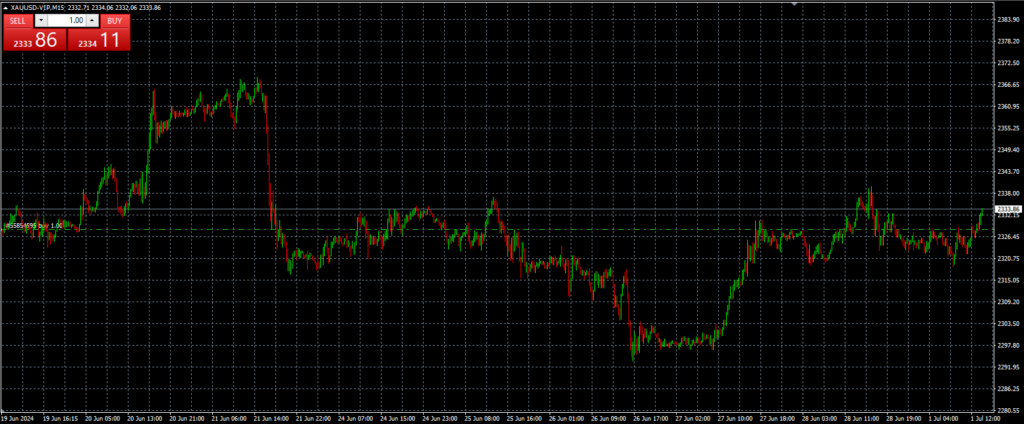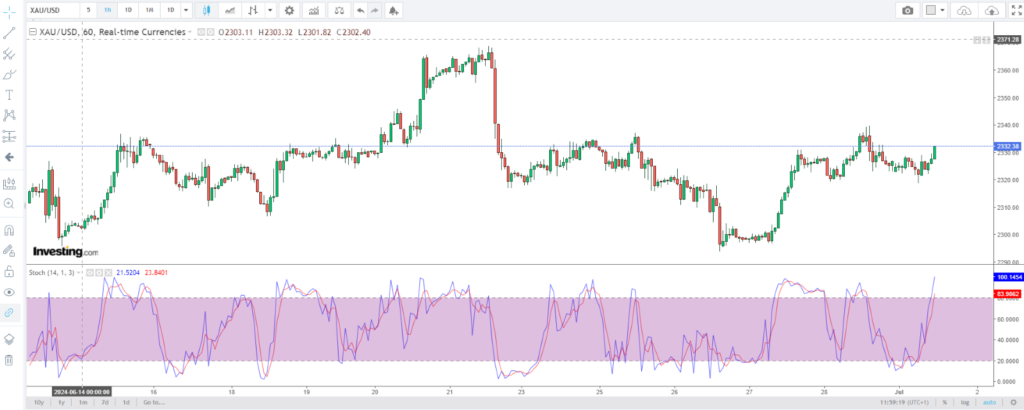
Key Points:
- PCE Data Impact: Anticipation of the US Personal Consumption Expenditures (PCE) Price Index release is causing marginal declines in gold prices, with potential volatility based on the results.
- Long-Term Uptrend: Despite recent dips, gold’s long-term uptrend remains intact, suggesting continued strength as a stable investment.
- Geopolitical Uncertainties: Ongoing geopolitical tensions, such as in the Middle East and Ukraine, are boosting gold demand as a safe haven.
- FOMC Sentiment: Mixed outlook on future rate cuts from the Federal Open Market Committee creates uncertainty for gold investors, potentially leading to price fluctuations.
As we anticipate the release of the US Personal Consumption Expenditures (PCE) Price Index for June, gold (XAU/USD) prices edge marginally upper 0.33%, trading in the $2,400. This economic indicator could inject volatility into the market, potentially shaking the recent stability of gold prices.
Daily Digest Market Movers: Gold Price Recovers the $2,400 Figure
Gold traders are focused on the release of key economic data, including Durable Goods Orders, the preliminary Q2 GDP number, and the Core PCE for June. Durable Goods Orders are expected to increase from 0.1% to 0.4% month-over-month (MoM). The Gross Domestic Product (GDP) for Q2 is projected to rise from 1.4% in Q1 2024 to 1.9% quarter-over-quarter (QoQ), indicating that the economy is accelerating as the year progresses. The Fed’s preferred measure of inflation, the Core PCE, is expected to dip from 2.6% to 2.5% year-over-year (YoY). The latest Consumer Price Index (CPI) data revealed a continuation of the disinflation process in the United States (US), boosting gold prices and increasing the likelihood that the Fed will cut interest rates starting in September.

The PCE Data’s Impact on Gold Prices
The PCE data is crucial as it is the Federal Reserve’s preferred inflation gauge. Higher inflation could prompt the Fed to adjust interest rates, impacting gold prices as gold is a non-interest-bearing asset. Stable or rising consumer spending could support a resilient economy, potentially leading to higher interest rates, which might negatively impact gold. Strong business investment would indicate economic health, possibly leading to higher interest rates. A robust GDP report could bolster the case for higher interest rates, affecting gold’s appeal.
FOMC Sentiment and the Mixed Outlook on Rate Cuts
The Federal Open Market Committee (FOMC) has a mixed outlook on future rate cuts. While some members anticipate the need for rate cuts in the near future, others remain cautious, creating an environment of uncertainty for gold investors. This mixed sentiment can lead to fluctuations in gold prices as investors react to the potential changes in monetary policy.
Geopolitical Uncertainties Boost Gold Demand as a Safe Haven
Geopolitical uncertainties continue to significantly influence the demand for gold as a safe haven. Tensions in the Middle East and the ongoing conflict in Ukraine are prime examples. These events create a backdrop of instability, prompting investors to turn to gold to protect their wealth and thereby influencing its price.
Finance and Gold Price Volatility
Financial markets are poised to react strongly to the upcoming PCE data. An inflation rate higher than expected could lead to significant volatility in gold prices, as investors adjust their strategies based on the new economic information.
Experts Weigh in on PCE Data and Potential Rate Cuts
Jim Reid of Deutsche Bank predicts a slight increase in core PCE, which could lower the year-on-year rate to its lowest in over three years. Raphael Bostic, Atlanta Fed President, expects a rate cut in Q4, suggesting a potential series of cuts in 2025. Michelle Bowman, Fed Board of Governors, cautions that the Fed is not yet considering rate cuts.
Regional Factors Shaping Global Gold Demand
The global economic outlook remains mixed, with varying inflation and growth rates across regions influencing gold demand differently.

In the United States, potential volatility around the November election and the Federal Reserve’s interest rate decisions will be significant drivers of gold prices. These political and economic factors create an environment of uncertainty, which can lead to fluctuations in the demand for gold as investors seek safe havens.
In Asia, there is increased gold demand from central banks hedging against currency devaluation. This regional trend highlights the strategic importance of gold as a stable asset amidst economic uncertainties.
In Europe, economic stability and ongoing geopolitical tensions play a crucial role in shaping gold’s appeal. The region’s economic health and political landscape significantly influence investor sentiment towards gold. Understanding these regional dynamics is essential for comprehending the global factors that drive gold demand and influence its price movements.
Investors Prepare for Market Swings as Gold’s Long-Term Stability Shines
Gold prices are poised for potential volatility following the release of the PCE inflation data. While the long-term outlook remains positive, with gold benefiting from geopolitical uncertainties and a possible Fed rate cut, the immediate future may see fluctuations based on economic data and Fed commentary.
Investors should brace for potential market swings and consider the broader economic indicators and geopolitical events that could shape gold’s trajectory in the coming months. Despite short-term volatility, gold’s role as a stable, safe store of value continues to underpin its long-term attractiveness.






